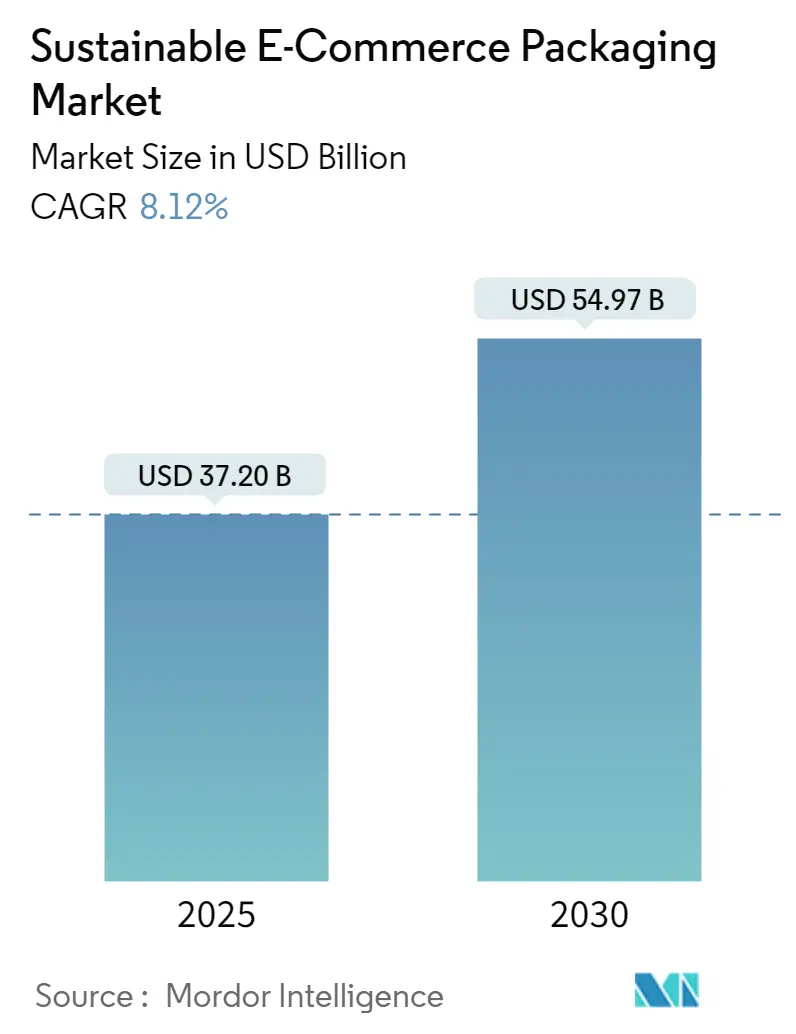
| Study Period | 2019 - 2030 |
| Market Size (2025) | USD 37.20 Billion |
| Market Size (2030) | USD 54.97 Billion |
| CAGR (2025 - 2030) | 8.12 % |
| Fastest Growing Market | North America |
| Largest Market | Asia Pacific |
| Market Concentration | Low |
Major Players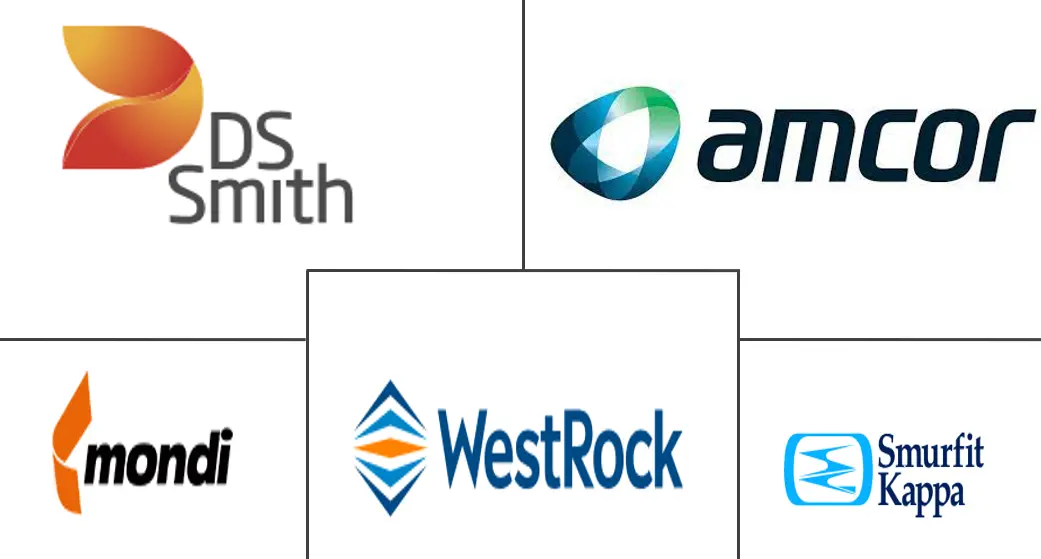
*Disclaimer: Major Players sorted in no particular order |
Sustainable E-Commerce Packaging Market Analysis
The Sustainable E-Commerce Packaging Market size is estimated at USD 37.20 billion in 2025, and is expected to reach USD 54.97 billion by 2030, at a CAGR of 8.12% during the forecast period (2025-2030).
Manufacturers and consumers are becoming more aware of the environmental consequences of packaging waste, resulting in an incremental need for sustainable packaging solutions that reduce waste and utilize eco-friendly materials. The behavior of eco-conscious consumers in developed regions like Europe and North America gravitates toward environmentally sustainable packaging, which can be made from recycled, biodegradable, or compostable materials.
- Sustainability is a major driver of purchase decisions and brand affinity in e-commerce. Retailers and e-commerce packaging vendors are taking action by incorporating sustainable packaging choices like corrugated boxes made from recycled materials, paper-based alternatives, and simplistic designs that decrease material usage.
- E-commerce stakeholders substantially recognize the requirement to make sustainable packaging viable for small businesses that supply products to these platforms to achieve targets. This comes when multiple governments and individual retailers look for options to curb the usage of single-use plastic. Several e-commerce companies are banning single-use plastics in their packaging supply chain.
- For instance, in July 2023, Walmart unveiled its groundbreaking decision to help make the everyday shopping experience more sustainable by reducing packaging waste related to online purchases. The firm is moving from plastic to recyclable paper mailers. Rightly-sized cardboard box packaging would allow customers to consolidate shipping on e-commerce orders and eliminate the use of disposable plastic bags. This switchover was estimated to remove 65 million single-use plastic bag mailers, or over 2,000 metric tons of plastic waste, from United States landfills by the end of 2023.
- The past few years have seen a continual consumer purchasing shift toward e-commerce and away from brick-and-mortar stores. The use of online shopping in the United States has been increasing in the past few years. According to the US Census Bureau, e-commerce retail sales as a percentage of total retail sales in the United States increased from 9.1% in 2017 to 15.4% in 2023. The surge in online purchases necessitates the need for effective, eco-friendly, and sustainable packaging choices.
- However, fluctuations in the raw material prices backed by the constant supply chain-related issues caused by sudden geopolitical events (like the conflict between Ukraine and Russia and other trade tensions between countries) may dent the market's top line in the upcoming period. Fluctuations in the prices of raw materials have the potential to impact the total production expenses and subsequently impact the ultimate pricing of the completed products or services.
- As the e-commerce sector grows, technological advancements are being developed to ensure customer safety and security. Examples of such advances include shipment applications facilitated by sustainable RF and RFID labels, which help track the product, the manufacturer's facility, the information of the delivery partner, and the shipper’s warehouse. Online shopping is becoming increasingly popular in both developed and emerging markets like Indonesia, India, etc., and customers are taking advantage of convenient packaging solutions that monitor product information during the shipment and delivery process, providing lucrative market opportunities.
Sustainable E-Commerce Packaging Market Trends
Online Sales of Consumer Electronics is Expected to Drive Top-Line
- Manufacturers of consumer electronics packaging products are increasingly using protective packaging items, such as air bubble wraps, air pillows, and other inflated packaging products, to shield devices. It is anticipated that in the future, these packaging alternatives will satisfy the requirements of all electronic categories. The packaging of small consumer goods in blisters works effectively. This plastic packaging makes the items stand out and offers tamper protection while still being straightforward to open.
- Electronic product packaging that is environmentally friendly is growing in popularity. Regulators and government authorities have vigorously pushed for eco-friendly or green packaging. Brands and consumers alike are recognizing the necessity of protecting the environment from non-biodegradable packaging trash. For instance, in January 2023, Flipkart introduced an e-store for sustainable products. The company hopes that it will be able to make a difference and encourage informed buying decisions while being transparent, consumer-oriented, and eco-friendly.
- According to the investment analysis firm Avendus and a key CA firm based out of India, Dewan P.N. Chopra & Co., the size of the consumer electronics market across India from 2017 is expected to increase almost five times by 2025 to USD 30.6 billion. Therefore, this significant uptick in online consumer electronics across the country is anticipated to push the demand for recyclable and biodegradable sustainable packaging options in the coming years.
- Several global companies like Amazon, Alibaba, Walmart, and others are gradually understanding that the environmental impact of devices extends to packaging as well. Amazon set a robust objective to have all Amazon device packaging completely recyclable by the end of 2023, a new record for the consumer electronics sector. About 79.5% of product launches in 2022 were fully recyclable.
- Using appropriate materials is crucial in making consumer electronics packaging sustainable. By carefully selecting the materials for wrapping, packing, and transporting electronics, it becomes simpler to achieve business' carbon emission targets and sustainability objectives. Embracing sustainable packaging solutions for electronic products not only helps in reaching these goals but also attracts the increasing population of environmentally conscious consumers who prioritize eco-friendly choices.
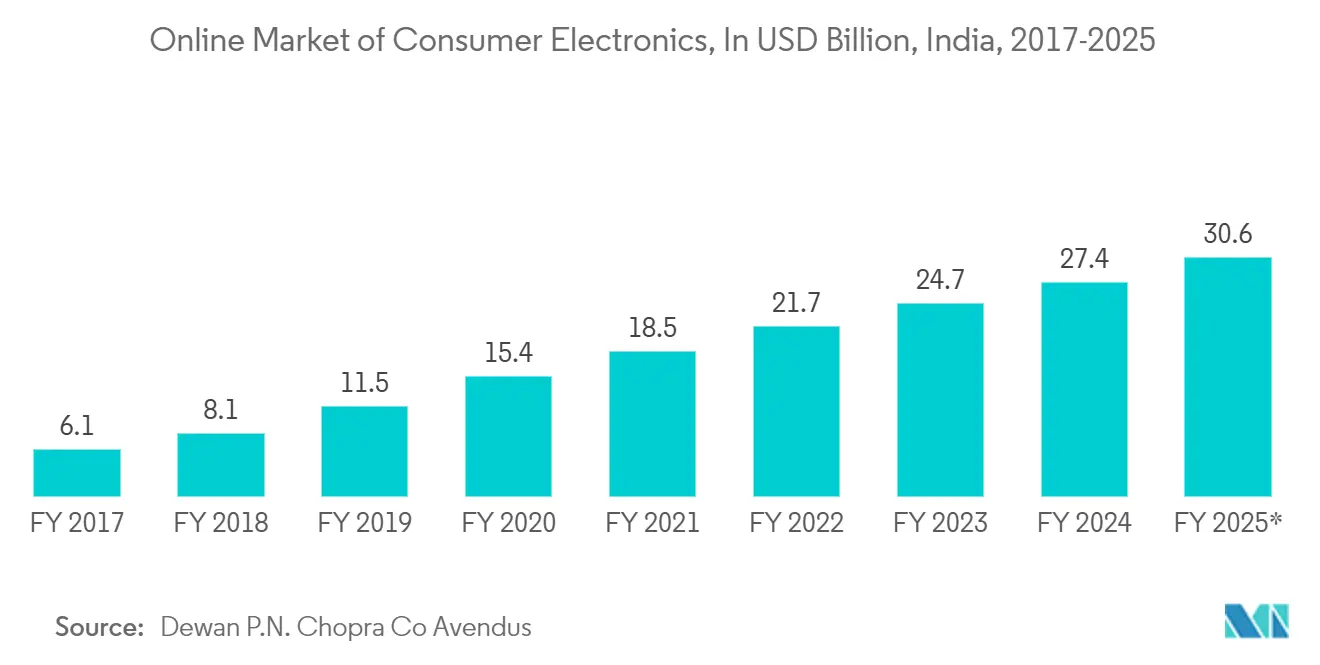
North America to Hold Significant Market Share During the Forecast Period
- The COVID-19 pandemic accelerated the transition to e-commerce sales and raised awareness of the environment and sustainability in the United States. Consumers increasingly turned to online shopping, and that pattern endured even when stores reopened, resulting in the demand for eco-friendly packaging. E-commerce spending in the United States is rising, driven by the convenience of home delivery, merchants’ omnichannel capabilities, and contextual customer experiences.
- The United States Plastics Pact recently published its annual report, highlighting its efforts to create a circular economy for plastics, primarily through a reassessment of packaging design. The consortium has successfully achieved its initial objective of identifying a list of problematic and unnecessary materials that it seeks to eliminate from plastic packaging by 2025. However, other aspirations, such as ensuring that all plastic packaging is reusable, recyclable, or compostable, may not be met by the 2025 deadline.
- Several players across the region consistently make efforts by launching products or starting initiatives with vertical or horizontal integration to boost environment-friendly packaging for e-commerce channels. In June 2023, Boox, a sustainable e-commerce platform, partnered with ReturnBear, a package-free returns network in Canada. This collaboration aims to enhance Boox's services in the Canadian market by promoting a more circular system within the e-commerce industry. As a result, Boox will extend its solutions and services to industry partners throughout Canada, effectively implementing the packaging loop within the region.
- Canada’s e-commerce infrastructure is highly developed and closely integrated with that of the United States. The major online retailers in Canada include Amazon, Walmart, Canadian Tire, Costco, Best Buy, Hudson’s Bay, and Etsy. Overall, North American consumers increasingly rely upon the Internet to place orders. Internet consumer sales have grown more in the past decade than traditional retail sales.
- The total percentage of e-commerce is rapidly growing in terms of total retail sales, primarily in developed countries like the United States and Canada. According to the US Census Bureau, the value of retail e-commerce sales in the United States has been growing significantly, especially after the pandemic. In 2023, the value of e-commerce retail trade sales in the United States exceeded USD 1.118 trillion, marking a significant increase from USD 762.68 billion in 2020. Overall, as consumer lifestyles and food demands change and retailers work closely to accommodate those demands, packaging is anticipated to experience a dynamic transformation.
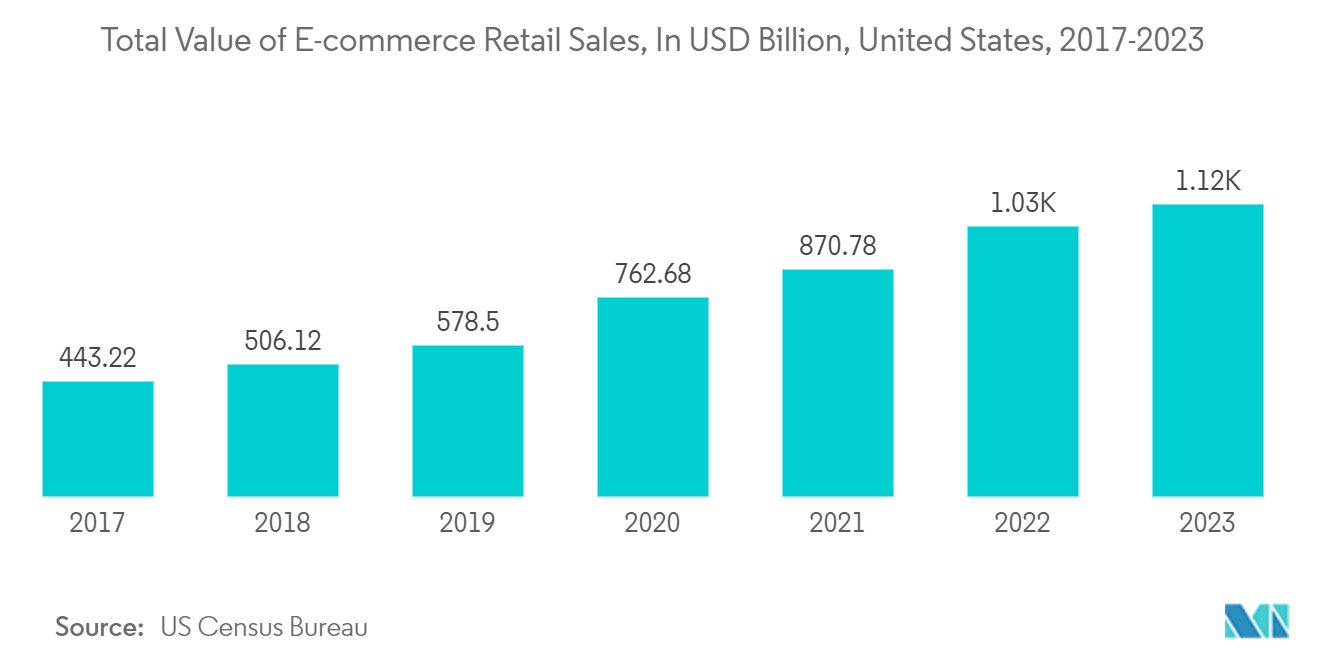
Sustainable E-Commerce Packaging Industry Overview
The market studied is fragmented, with major vendors accounting for most of the market share. The presence of many players in the market impacts the pricing of services, making it a direct competing factor, especially for small-scale vendors. The vendors are expected to focus on providing one-stop-shop services, providing them with a competitive advantage. Some of the major players in the market are Amcor Group GmbH, Smurfit Kappa Group, WestRock Company, and DS Smith PLC.
- September 2023: Global sustainable and e-commerce packaging firm Smurfit Kappa notified its intentions to acquire a key paper and paperboard manufacturing firm, WestRock, for USD 11.2 billion to create Smurfit WestRock, one of the largest global paper packaging company generating a combined annual income of USD 34 billion. Upon the declaration, the agreement was anticipated to be finalized during the second quarter of 2024.
- June 2023: Procter & Gamble (P&G) China unveiled its partnership with Dow, a key material specialist firm, to introduce an air capsule for e-commerce packaging. The capsule has been created to minimize unnecessary packaging while ensuring the products' safety. Dow has stated that the innovative design is inspired by corrugated parcel boxes and results in a 40% decrease in material weight. Additionally, it features an all-PE mono-material composition.
Sustainable E-Commerce Packaging Market Leaders
-
Amcor Group GmbH
-
Smurfit Kappa Group Plc
-
DS Smith Plc
-
Mondi Group
-
WestRock Company
- *Disclaimer: Major Players sorted in no particular order
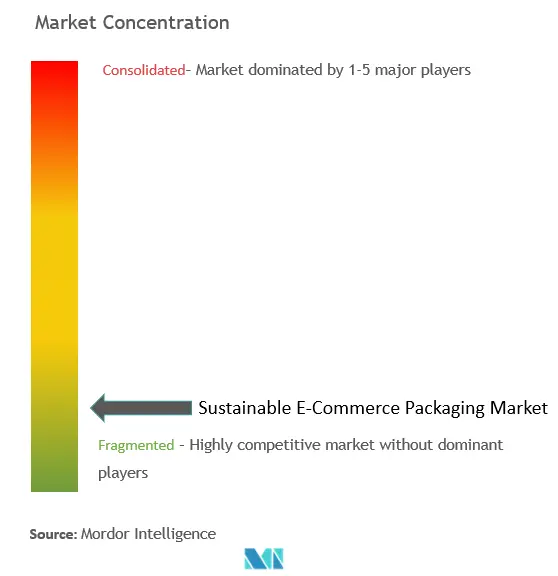
Sustainable E-Commerce Packaging Market News
- April 2024: DS Smith, a packaging solutions provider, came into an agreement with a Swedish producer of sustainable e-commerce bags, Jonsac, to speed up the transition from plastic packaging to eco-friendly paper alternatives in the European e-commerce sector. The existing partnership between Jonsac and DS Smith, which previously involved the supply of paper bag solutions to DS Smith customers in the Nordic region, has now been expanded. As a result, Jonsac's 100% recyclable, FSC-certified paper bags will be accessible in all DS Smith markets across Europe.
- June 2023: Mondi expanded its foothold in the International Safe Transit Association (ISTA) and Amazon Packaging Support and Supplier Network (APASS) certified Performance Lab services to address the growing demands of e-commerce customers. The Performance Lab was specifically created to assess the durability and excellence of sustainably packaged e-commerce packaging in real-life scenarios. The firm aims to pinpoint any shortcomings or weaknesses in the e-commerce packaging through data-driven evaluations.
Sustainable E-Commerce Packaging Industry Segmentation
Based on current trends and market dynamics, the study tracks and analyzes the demand for sustainable e-commerce packaging within the end-user industry. The market numbers are derived by tracking the revenue generated by players providing sustainable e-commerce products across the end-user industries in the retail sector. The study provides a detailed breakdown of the various types of material across different geographies. This report analyzes the factors based on the prevalent base scenarios, key themes, and end-user vertical-related demand cycles.
The report covers sustainable e-commerce packaging companies. The market is segmented by material type (plastic, paper, and paper board metals), end user (fashion and apparel, consumer electronics, food and beverage, pharmaceuticals, personal care, and other end users), and geography (North America (United States and Canada), Europe (United Kingdom, Germany, France, Italy, Spain, and Rest of Europe), Asia-Pacific (China, India, Japan, Australia, and Rest of Asia-Pacific), Latin America (Brazil, Mexico, Argentina, and Rest of Latin America), Middle East and Africa (United Arab Emirates, Saudi Arabia, South Africa, and Rest of Middle East and Africa). The report offers market sizes and forecasts in value (USD) for all the above segments.
| By Material Type | Plastic | ||
| Paper and Paper Board | |||
| Metal | |||
| By End User | Fashion and Apparel | ||
| Consumer Electronics | |||
| Food and Beverage | |||
| Pharmaceuticals | |||
| Personal Care | |||
| By Geography *** | North America | United States | |
| Canada | |||
| Europe | United Kingdom | ||
| Germany | |||
| France | |||
| Italy | |||
| Spain | |||
| Asia | China | ||
| Japan | |||
| India | |||
| Australia and New Zealand | |||
| Latin America | Brazil | ||
| Argentina | |||
| Mexico | |||
| Middle East and Africa | Saudi Arabia | ||
| United Arab Emirates | |||
| South Africa | |||
Sustainable E-Commerce Packaging Market Research Faqs
How big is the Sustainable E-Commerce Packaging Market?
The Sustainable E-Commerce Packaging Market size is expected to reach USD 37.20 billion in 2025 and grow at a CAGR of 8.12% to reach USD 54.97 billion by 2030.
What is the current Sustainable E-Commerce Packaging Market size?
In 2025, the Sustainable E-Commerce Packaging Market size is expected to reach USD 37.20 billion.
Who are the key players in Sustainable E-Commerce Packaging Market?
Amcor Group GmbH, Smurfit Kappa Group Plc, DS Smith Plc, Mondi Group and WestRock Company are the major companies operating in the Sustainable E-Commerce Packaging Market.
Which is the fastest growing region in Sustainable E-Commerce Packaging Market?
North America is estimated to grow at the highest CAGR over the forecast period (2025-2030).
Which region has the biggest share in Sustainable E-Commerce Packaging Market?
In 2025, the Asia Pacific accounts for the largest market share in Sustainable E-Commerce Packaging Market.
What years does this Sustainable E-Commerce Packaging Market cover, and what was the market size in 2024?
In 2024, the Sustainable E-Commerce Packaging Market size was estimated at USD 34.18 billion. The report covers the Sustainable E-Commerce Packaging Market historical market size for years: 2019, 2020, 2021, 2022, 2023 and 2024. The report also forecasts the Sustainable E-Commerce Packaging Market size for years: 2025, 2026, 2027, 2028, 2029 and 2030.
Our Best Selling Reports
Sustainable E-Commerce Packaging Industry Report
Statistics for the 2025 Sustainable E-Commerce Packaging market share, size and revenue growth rate, created by Mordor Intelligence™ Industry Reports. Sustainable E-Commerce Packaging analysis includes a market forecast outlook for 2025 to 2030 and historical overview. Get a sample of this industry analysis as a free report PDF download.




